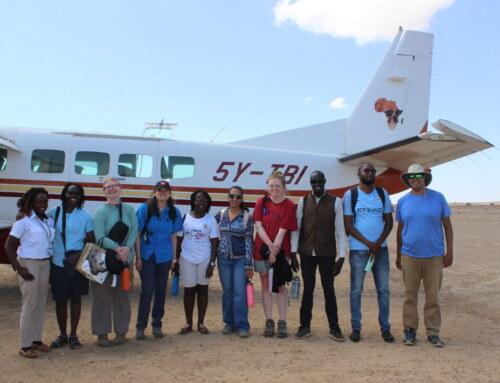The ancient task, new every day, of finding water on Africa’s arid plains. Celebrating a wedding by sacrificing and roasting a goat. Bringing electricity and modern health care to people who dwell in palm-frond huts and count their wealth in cattle. Sixteen students from Stony Brook University’s School of Journalism spent 10 days at TBI over the 2013 winter break reporting these stories, and more. Their project, “Turkana: Challenges in a Stark Land,” examines how the Turkana people, semi-nomadic pastoralists, are coping with the pressures of the 21st century.

Students in the Journalism Without Walls program, along with their professors (Ilana Ozernoy, kneeling second from left, and Barbara Selvin, standing second from right) and translators from TBI, pose in the middle of crossing the Turkwel River, which flows beneath the institute. TBI Director Lawrence Martin, standing third from left, helped team members through the deepest stretch of the crossing.
The trip came about as a result of an invitation from Richard Leakey to Howard Schneider, dean of the journalism school, to send student reporters to explore the region. The school’s Journalism Without Walls course, which had previously visited China, Russia, the Mississippi Gulf Coast and Cuba, was the perfect vehicle for the trip.
Journalism professors Barbara Selvin and Ilana Ozernoy, along with Frederic Courbet, a Nairobi-based photojournalist with extensive experience in Turkana, arrived with the students at TBI on Jan. 10, 2013. In addition to room and board, TBI provided transportation and translators, a group of bilingual Turkana men who work in various roles at the institute. The translators, the students and the faculty forged deep bonds as they traveled from village to village. The students also reported on TBI’s search for energy self-sufficiency and its efforts to improve maternity care and to share low-cost energy technology with the Turkana.
Browse the essays in this project:
- Educated Turkana Women Choose Modernity Over Tradition
by Alyssa Melillo - In One Turkana Village, A Solar-Powered ‘Electro-hut’by Michael Ruiz
- Turkana: A Harsh Land, A Fierce Pride
by Deanna Del Ciello - ‘Waste’ Fuels Scientists’ Efforts
by Dipti Kumar, Michael Ruiz and Ansa Varughese - Fossil Hunter Leakey Searches for Fuels of the Futureby Dipti Kumar and Ansa Varughese
- I Am Turkana
by Frank Posillico - Gardeners Take a Stake in Nomadic Desert Cultureby Khloe Meitz
- Songs at a Desert Lake
by Lindsey Welling





